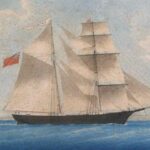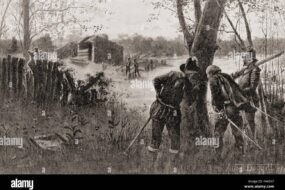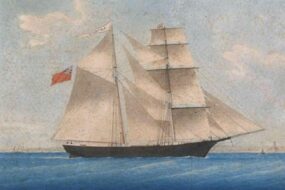
Imagine being part of an elite team on a mission to uncover the secrets of the Northwest Passage, a fabled route that promises to revolutionize global trade and exploration. You’re on the cutting edge of adventure, backed by the British Royal Navy, and equipped with the most advanced technology of your time. But as you venture into the unforgiving Arctic wilderness, the excitement quickly turns to desperation, and your journey becomes a fight for survival against the harshest environment on Earth. This is the story of the Franklin Expedition, a tale of ambition, mystery, and tragedy that has captivated the world for over a century and a half.
In 1845, Sir John Franklin, a seasoned explorer with a storied career behind him, led an expedition comprising 129 men, two ships – the HMS Erebus and the HMS Terror – and a mission to chart the unmapped sections of the Northwest passage. The British Admiralty was keen to assert its dominance over the seas, and Franklin’s voyage was seen as a critical step in this endeavor. With state-of-the-art steam engines, a year’s worth of supplies, and a crew that included some of the most talented sailors and officers in the Royal Navy, the expedition set off from Greenhithe, England, amidst fanfare and optimism. Little did they no, this journey would become one of the most enduring unsolved mysteries in the annals of maritime history.
As the expedition sailed into the Arctic, they encountered conditions that were far more brutal than anticipated. The summer of 1845 was unusually cold, and the ice that they expected to melt remained stubbornly frozen. By September, both ships became trapped in the ice off King william Island in what is now Nunavut, Canada. The crew made preparations for winter, but the harsh reality of their situation soon set in.The ice was not going to release them anytime soon, and the supplies, though ample for a short voyage, were not sufficient for the prolonged stay they were now facing. Franklin and his men tried to hunt and fish to supplement their rations, but the Arctic environment proved unforgiving, and their efforts were met with limited success.As the first winter turned into spring, and then into another long, grueling winter, the crew’s health began to deteriorate. The cold was intense, and the darkness was almost palpable. The men suffered from scurvy, hypothermia, and the psychological strain of being trapped. Sir John Franklin himself fell ill and died in June 1847, a devastating blow to the morale of the crew. command fell to francis Crozier, the captain of the HMS Terror, who faced the unfeasible task of keeping his men alive. Despite their best efforts, the situation continued to spiral out of control. In April 1848, after attempting to drag their ships and equipment across the ice, the remaining crew members abandoned ship, setting off on foot towards the Canadian mainland, a journey that was to be their last.
The fate of Franklin and his men remained a mystery for years, sparking numerous search missions. Lady Jane Franklin, Sir John’s wife, played a crucial role in organizing these expeditions, driven by her determination to uncover the truth. The search efforts were eventually rewarded with tantalizing clues – a few abandoned campsites, pieces of equipment, and most hauntingly, a note buried under a stone cairn that detailed the expedition’s tragic fate. The note, dated April 1848, revealed that the ships had been trapped since September 1846, that franklin had died, and that the surviving crew had abandoned ship. It was a chilling message that ended with a desperate hope for survival, but it was clear that the outcome was far from positive.
Some of the key factors that contributed to the expedition’s tragic fate include:
Harsh weather conditions: The Arctic environment proved to be much more unforgiving than anticipated, with unusually cold temperatures and persistent ice cover.
Inadequate supplies: The crew’s rations and equipment were not sufficient for the prolonged stay in the Arctic, leading to malnutrition and related health issues.
* Poor decision-making: Franklin’s decision to navigate the treacherous waters of the Northwest Passage and his failure to adapt to changing circumstances have been widely criticized.years later, in the 1980s, forensic analysis and archaeological findings began to piece together the final days of the Franklin Expedition. Remains found on King William Island told a grim story of starvation, cannibalism, and a slow, agonizing march towards oblivion. The Inuit, who had long known about the expedition’s tragic end, shared their oral histories, which included tales of white men stumbling across the ice, weak and dying. These accounts were corroborated by the discovery of the wrecks of the HMS erebus in 2014 and the HMS Terror in 2016, remarkably well-preserved in the cold Arctic waters.
The legacy of the Franklin Expedition is a complex tapestry of exploration, tragedy, and mystery. It stands as a testament to the hubris of human endeavor and the unforgiving nature of the Arctic environment. The expedition’s fate has inspired countless books, artworks, and documentaries, captivating audiences with its tragic narrative. Moreover, the search for Franklin has contributed significantly to our understanding of the Arctic and its challenges, paving the way for future explorers and scientists.
The story of the Franklin Expedition is a powerful reminder of the risks and rewards that come with exploration. As we look back on this tragic event, we are drawn into a world of heroism, loss, and the indomitable human spirit. The mystery of what exactly happened to Franklin and his men continues to fascinate us, a puzzle that, even after all these years, remains incompletely solved. Their story is a compelling chapter in the annals of history, a tale that continues to resonate with us today.Here is a brief timeline of the Franklin expedition:
| 1845 | Franklin Expedition sets off from Greenhithe, England |
| September 1845 | Ships become trapped in ice off King William Island |
| June 1847 | Sir John Franklin dies |
| April 1848 | Crew abandons ship and sets off on foot towards Canadian mainland |
#FranklinExpedition #ArcticExploration #NorthwestPassage #MysteryOfTheDeep #maritimehistory #UnsolvedHistory #TheInfographicsShow #truestory #HistoryBuff #DidYouKnow #LostAtSea #ArcticAdventures #HistoricalMysteries #DocumentaryStyle #HistoryNerd #GlobalFigures #InfographicStory #WorldHistory
<img class="bimage_class" src="https://campusstore.co.za/wp-content/uploads/2025/04/723ae3.jpg" alt="The Cursed Expedition: Unraveling the Mysterious Disappearance of the Franklin Expedition
Imagine being part of an elite team on a mission to uncover the secrets of the Northwest Passage, a fabled route that promises to revolutionize global trade and exploration. You’re on the cutting edge of adventure,backed by the British Royal Navy,and equipped with the most advanced technology of your time. but as you venture into the unforgiving Arctic wilderness, the excitement quickly turns to desperation, and your journey becomes a fight for survival against the harshest environment on Earth. This is the story of the Franklin Expedition, a tale of ambition, mystery, and tragedy that has captivated the world for over a century and a half.
In 1845,Sir John Franklin,a seasoned explorer with a storied career behind him,led an expedition comprising 129 men,two ships – the HMS Erebus and the HMS Terror – and a mission to chart the unmapped sections of the Northwest Passage. The British Admiralty was keen to assert its dominance over the seas, and Franklin’s voyage was seen as a critical step in this endeavor. With state-of-the-art steam engines, a year’s worth of supplies, and a crew that included some of the most talented sailors and officers in the Royal Navy, the expedition set off from Greenhithe, England, amidst fanfare and optimism. Little did they know, this journey would become one of the most enduring unsolved mysteries in the annals of maritime history.
As the expedition sailed into the Arctic,they encountered conditions that were far more brutal than anticipated. The summer of 1845 was unusually cold, and the ice that they expected to melt remained stubbornly frozen. By September, both ships became trapped in the ice off King William Island in what is now Nunavut, Canada. The crew made preparations for winter, but the harsh reality of their situation soon set in. The ice was not going to release them anytime soon, and the supplies, though ample for a short voyage, were not sufficient for the prolonged stay they were now facing. Franklin and his men tried to hunt and fish to supplement their rations, but the Arctic environment proved unforgiving, and their efforts were met with limited success.
As the first winter turned into spring, and then into another long, grueling winter, the crew’s health began to deteriorate.The cold was intense, and the darkness was almost palpable. The men suffered from scurvy, hypothermia, and the psychological strain of being trapped. Sir John Franklin himself fell ill and died in June 1847,a devastating blow to the morale of the crew. Command fell to Francis crozier, the captain of the HMS Terror, who faced the impossible task of keeping his men alive. Despite their best efforts,the situation continued to spiral out of control. In April 1848, after attempting to drag their ships and equipment across the ice, the remaining crew members abandoned ship, setting off on foot towards the Canadian mainland, a journey that was to be their last.
The fate of Franklin and his men remained a mystery for years,sparking numerous search missions. Lady Jane Franklin, Sir John’s wife, played a crucial role in organizing these expeditions, driven by her determination to uncover the truth. The search efforts were eventually rewarded with tantalizing clues – a few abandoned campsites, pieces of equipment, and most hauntingly, a note buried under a stone cairn that detailed the expedition’s tragic fate. The note, dated April 1848, revealed that the ships had been trapped since September 1846, that Franklin had died, and that the surviving crew had abandoned ship. It was a chilling message that ended with a desperate hope for survival, but it was clear that the outcome was far from positive.
Years later, in the 1980s, forensic analysis and archaeological findings began to piece together the final days of the franklin expedition. Remains found on King William Island told a grim story of starvation, cannibalism, and a slow, agonizing march towards oblivion. The Inuit, who had long known about the expedition’s tragic end, shared their oral histories, which included tales of white men stumbling across the ice, weak and dying. These accounts were corroborated by the discovery of the wrecks of the HMS Erebus in 2014 and the HMS Terror in 2016, remarkably well-preserved in the cold Arctic waters.
The legacy of the Franklin expedition is a complex tapestry of exploration, tragedy, and mystery. It stands as a testament to the hubris of human endeavor and the unforgiving nature of the Arctic environment. The expedition’s fate has inspired countless books, artworks, and documentaries, captivating audiences with its tragic narrative. Moreover, the search for Franklin has contributed significantly to our understanding of the Arctic and its challenges, paving the way for future explorers and scientists.
The story of the franklin expedition is a powerful reminder of the risks and rewards that come with exploration.As we look back on this tragic event, we are drawn into a world of heroism, loss, and the indomitable human spirit. The mystery of what exactly happened to Franklin and his men continues to fascinate us, a puzzle that, even after all these years, remains incompletely solved. Their story is a compelling chapter in the annals of history, a tale that continues to resonate with us today.
#FranklinExpedition #ArcticExploration #NorthwestPassage #MysteryOfTheDeep #MaritimeHistory #UnsolvedHistory #TheInfographicsShow #TrueStory #HistoryBuff #DidYouKnow #LostAtSea #ArcticAdventures #HistoricalMysteries #DocumentaryStyle #historynerd #GlobalFigures #InfographicStory #WorldHistory”>










